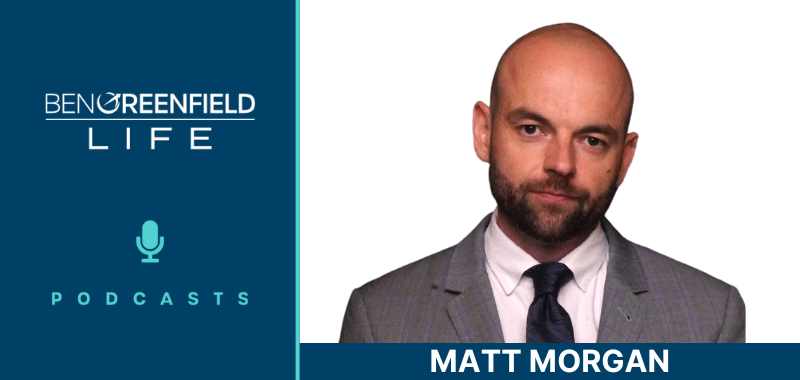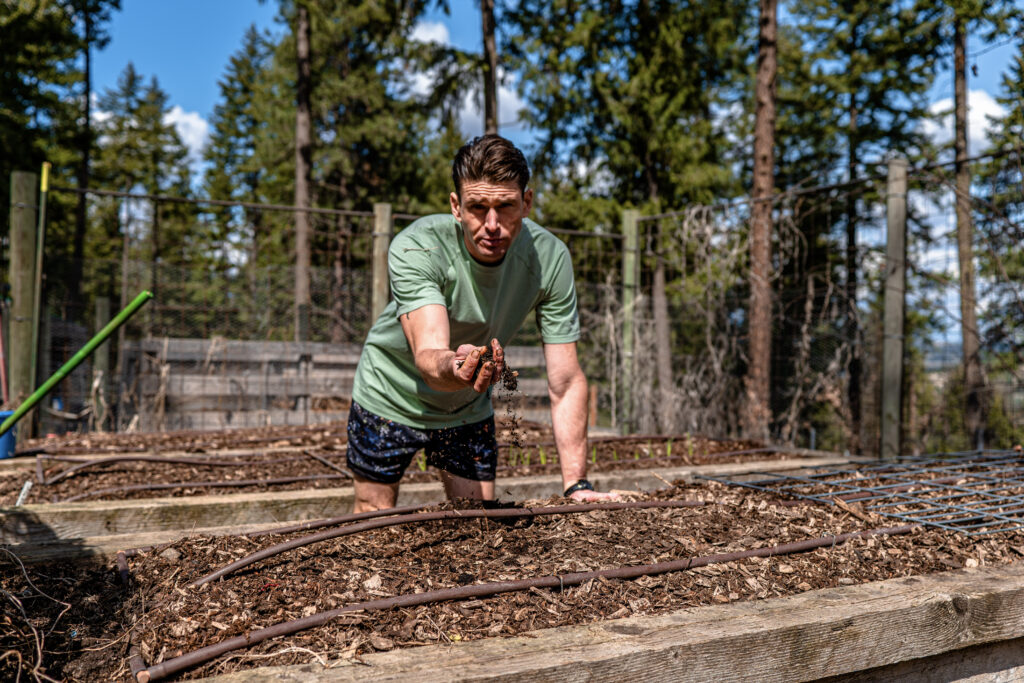June 1, 2021
You don’t need me to tell you that it’s been a challenging and uncertain time—we’ve all been tested in different ways throughout these months of the pandemic, social turbulence, and isolation.
With everything that is in flux at the moment, it seems that the only thing you may be certain of is the presence of uncertainty.
In a recent article, I took an in-depth look at the psychology and societal impact of the COVID lockdowns, and the results of the emerging research are troubling, to say the least.
Who knows when this pandemic will end? It seems like things may be starting to get “back to normal,” but what does that even mean anymore, and what if it doesn't stick? When seemingly everything you may think you know is in question and unsettled, it would be understandable (and even expected) if you were on edge. Given that stress tends to be the root cause of many ailments, it’s something I’ve written extensively about in the past. (Back when I wrote this article about chronic stress nearly a year ago, who could've predicted that we were just getting started with COVID…). With the state of the world right now, it feels more important than ever to take another look and provide you with the latest insights from neuroscience to support you in the critically important aim of managing stress and building resiliency.
In this article, I'll focus on what research has to say about the nature of stress—particularly how it relates to uncertainty—much of which would appear to be specifically tailored to current circumstances. According to the review article Uncertainty and stress: Why it causes diseases and how it is mastered by the brain, “Stress responses are elicited, when the environment changes and the individual becomes uncertain about which strategy to select in order to safeguard his/her future well-being.” If that doesn’t describe at least some part of your past year, you’re definitely in the fortunate minority.
In the past, I’ve covered a wide variety of strategies for coping with stress, including meditation, utilizing wearables like the Apollo or the Hapbee, optimizing sleep, biohacking your meditation and naps, and I even talked more about breathwork last week (and I'm going to keep revisiting it—here and in the future—because it's such a worthwhile tool). However, it’s important to also understand the root causes of stress in order to more effectively mitigate the negative effects.
So how do you get clear on the way forward in times of turbulence? Left unchecked, stress leaves you less capable of responding, prone to reactive behavior, leading to a vicious cycle that results in more stress. You may have heard of three possible responses to stressful situations: fight, flight, or freeze. In this article, I consider a fourth: forward motion.
Uncertainty and Stress: A Neuroscience Perspective
Basic, everyday, chronic stress drives tens of millions of people to the point of illness, depression, and self-destruction, and that’s without the amplification of our decidedly non-basic every day right now. According to research from Harvard Medical School, stress is responsible for 90% of all doctor visits. With prolonged uncertainty being one of the most insidious stressors you face, I want to investigate its contribution to the “hidden killer” of stress.
So what is uncertainty and why does it stress you out?
According to Mazen Kheirbek, Ph.D., “Uncertainty is not knowing what is going to happen.”
Obvious, right?
But it's also worthy of restating for clarity and direction. Your brain is a prediction machine—constantly trying to make assumptions that allow you to comprehend and navigate the world around you. It’s not likely that you’ve lived through a pandemic before, and right now it still may feel like everything is up in the air, without clear “rules” about how you should behave on a day-to-day basis, how you should interact with friends and family, even whether the kids are in school or you are at the office. When your brain is working to evaluate the changing environment (looking to decrease uncertainty as fast as possible), it enters a hypervigilant threat monitoring mode. Reducing uncertainty requires cerebral energy. If your brain cannot reduce uncertainty, “allostatic load” (which I will touch on shortly) can contribute to systemic issues and brain malfunction (impaired memory, atherogenesis, diabetes, and subsequent cardio- and cerebrovascular events).
One of the issues is when this search to reduce uncertainty is prolonged, your body reacts to hypothetical threats as if they are right in front of you, and constantly imagining the worst outcomes takes its toll. One way you can visualize stress is as a search for homeostasis—when your internal equilibrium has been disturbed in some way, stress can be seen as a non-specific response by your body to this demand for change.
A 2016 study published in Nature Communications gives some insight into the basis of the relationship between stress and uncertainty, finding that most people would rather know for certain that they’re going to get an electric shock than to not be able to predict it. Specifically, one of the conclusions was that situations in which subjects had a 50% chance of receiving a shock were the most stressful, while 0% and 100% chances were the least stressful. One of the reasons for this response, as mentioned above, is the need for your brain to enter that threat monitoring mode in the presence of uncertainty. You need to be on alert, figuring out which decisions to make, and constantly being on high alert increases your stress levels.
The Mind/Body Connection
The way your body reacts to the demand for change is through allostasis, defined as the “process of maintaining homeostasis through the adaptive change of the organism's internal environment to meet perceived and anticipated demands.” When your physiological, psychological, and spiritual adaptations have been significantly taxed (see: current state of affairs), allostatic load comes into play. In an ideal balance of homeostasis, you are adapting to change and challenge effectively.
However, when issues like chronic stress, overexertion, work/financial stress, etc. overload you, systemic physiological and psychological problems begin to arise.
One of the big issues is that many of these potential sources of stress might pass below your conscious awareness—you more than likely live a seemingly comfortable lifestyle, yet your body could be constantly sending a message to prepare for battle, that the environment is not safe. In studies conducted with mice, a distinction is made that may shed some light on how uncertainty plays a role here, namely that…
…uncertainty emerges when an animal is not clear about the way forward, and anxiety emerges when the perceived way forward may contain a threat.
So even though you might feel safe, your body could potentially be under a significant amount of nervous system stress, trying to calculate the next step, often spinning and searching subconsciously and keeping you hardwired in a fight-and-flight, sympathetic nervous system mode. There is a human need to feel safe, and when the way forward is hazy at best, uncertainty throws that safety into question, resulting in agitation and a host of negative health effects.
From an evolutionary standpoint, if you were being chased by a lion (an acute stressor), you want the cascade of stress to aid you in self-preservation. However, the reoccurring uncertainties and ambiguities leading to stress send a message to the more primitive parts of your brain and physiology that you are constantly being chased by the lion (even if you happen to just be stuck in a traffic jam). Again, perpetually being in a state of trying to deal with hypothetical threats as if they are right in front of you is a way of being that is not sustainable for very long without chaotic consequences.
3 Ways To Adopt A Forward Motion Mindset
It is not an avoidance of stressors and uncertainty that is necessary (because of course, that's not possible), but rather it is necessary to learn how to control and modulate your response. Author Nassim Taleb introduced the concept of “antifragile” in his book Antifragile: Things That Gain From Disorder. Taleb defines antifragile entities as those that get stronger when subjected to stress and uncertainty. So if you are able to adopt an antifragile mindset, you can realize and even appreciate the stress that you face, knowing that you will benefit from moving through rather than resisting. You can aim to reframe your outlook and use a set of stressful circumstances as a way to become better at “adapting to the unknown” with a mindset of forward motion.
1. Positive Association
If you've ever tried to ignore your stress, you know it is not an effective strategy (if only you could turn our brain off, right?). Navigating stressors productively actually requires turning your attention to what's happening as a starting point for forward motion. Most therapies work by bringing you into a state of heightened awareness of the stress or trauma first, then pairing that alertness with something new, like a positive relationship with the therapist.
I talked about this practice extensively with Dr. Don Wood in this recent podcast episode. Dr. Wood treats trauma by working with patients to attach positive sensations and memories to the traumatic event. His TIPP (The Inspired Performance Program) program not only addresses trauma, but is effective in mitigating other conditions like anxiety, addiction, and PTSD. He did a session with me and my family that you can learn about in the podcast; it was really powerful and productive. (By the way, you can get 15% off Dr. Wood's program with code BEN15.)
2. Setting Milestones
Even just a repurposing of the fear or uncertainty you are feeling will place you on the right track—looking at the neuroscience of goals and behavior change, it has been found that when you feel you are simply on the path to achieving a goal, you’re able to tap into reward pathways (such as dopamine release), building momentum that carries you forward. Dopamine buffers the adrenaline that surges through your body when you're experiencing stress.
Establishing doable milestones on the path to a final goal is critical to activate that reward system. Each step that you take successfully will motivate you to move forward and then move forward from there, and so on. For example, say you have a big presentation to deliver at work, with piles of research, design, and writing to get done, and the stress of completing the project (probably at home, maybe even with school-aged kids who are home during the pandemic) feels entirely overwhelming. Creating a set of doable tasks building towards the completion of the project will lessen the stress load significantly, because along the way as you take forward motion towards that goal, you will be naturally rewarded, encouraging you to continue on, step by step, until the presentation is complete.
3. Moving
Thus far, I have presented forward motion as a concept—a mindset that serves as a way of relating to your stressful circumstances in a productive manner. However, literal forward motion, as in moving your body through the space in front of you, plays a role in the mind/body stress connection as well. Stanford’s Dr. Andrew Huberman has conducted fascinating research to support the connection between the visual field, stress, and forward motion. It’s been shown that forward movement in the face of agitation activates the winning circuit in the brain (linked to boldness and courage).
So why might physical forward motion help to reduce stress? One of the key factors is the concept of optic flow, the motion pattern generated to an eye that is moving relative to the environment. “The actual movement of objects past us as we walk quiets some of the circuits that are responsible for stress,” according to Dr. Huberman. Expansion of vision through walking or forward movement can be a straightforward way to look at reducing stress. Something as simple as going outside for a walk, looking at the horizon, or getting your eyes off of a screen will go a long way.
Another reason this “expansion of vision” is critical in managing stress is that due to ancient hard-wired mechanisms, an immediate impact of stress is that it causes your pupils to dilate and narrow your vision. If you think of it in terms of implementing strategies to relax your pupil, your state will follow. Psychologist Francine Shapiro developed a technique while walking in the forest behind Stanford known as “Eye Movement Desensitization and Reprocessing” or “EMDR.” Subsequent studies have shown that goal-directed eye movements suppress fear-related amygdala activity during recall of traumatic memory. Forward motion (or the perception of forward motion with lateral eye movements) may create distance from the negative emotions of a traumatic experience. Lateralized eye movements quiet the activity of the amygdala, the limbic structure in the brain that's primarily responsible for threat detection and stress, and when you step forward to encounter the world by walking, your eyes move laterally back and forth to help guide you through space, which may help resolve the stress response.
So while I'm not a fan of blasting yourself to smithereens for hours on an elliptical trainer or treadmill, engaged in hormone or adrenal-depleting and exhaustive chronic cardio, I do recommend that you go on a walk, preferably outdoors. Regularly. It's a more powerful method of engaging in forward motion than you may think, and I do it every day, often multiple times, and especially when stressed. When I go on these walks, I watch the horizon, move my eyes side to side, and of course, breath. Speaking of breathing…
Stress & Breath
In order to be able to access a state of mind that separates you from uncertainty-induced stress, you need to be conscious of what's happening first. Breathwork is the fastest and best way to reach that awareness—you can control your diaphragm, which means you control your breathing, which means you control your heart rate, which means you control your alertness. The calming and focusing effect of breathing has been well-examined and represents a bridge between the conscious and unconscious control of the body.
There is an inextricable bidirectional relationship between stress and your body's physiological response. When you experience stress, this will inevitably represent itself in physiological response, and vice versa—your body and brain communicate back and forth with each other. Short and rapid breathing is controlled by the sympathetic nervous system, which is part of your “fight or flight” response, while slow, deep breathing stimulates the parasympathetic reaction, activating the “rest and digest” response. The diaphragm is real-time control over your brain state.
I have discussed the relationship between breathwork and stress plenty in the past, and the breath goes much deeper than just stress management: aside from dissolving stress and tension, releasing built-up emotion, expanding perspective, re-establishing courage and strength, and bringing about an internal realignment with body, mind, and soul, breathwork has the potential to also heal deep, core wounds and promote spiritual awakening.
Humans have been turning to breath as a stress-reducing tool well before formal neuroscientific research supported it. There are many techniques that are quickly accessible in order to take advantage of the power of breath to manage stress. For example, a breath walk combines breathing ratios, intervals, and breath types by synchronizing your breathing with walking steps and focused attention. You can direct your attention to personal growth, pain management, or relaxation during this type of walk. My current favorite form of breathwork, SOMA breath, which I discussed recently here, has historical origins that are thousands of years old, but doesn't lend itself too well to walking and is better done laying down, sitting in a sauna, etc. (If you're interested in trying SOMA breathwork, I highly recommend the 21-Day Awakening Journey, and you can use code BEN for a hefty $200 off.) However, there are other forms of breathwork that work quite well for walking, such as box breathing (4 in, 4 hold, 4 out, 4 hold), nasal breathing with long exhales (2 in, 4 hold, 10 out, for example), or the use of a breath device such as a Relaxator during short or long walks (check out a video of me walking with my Relaxator here!).
Summary
We’ve just wrapped up Stress Awareness Month—held every April since 1992—and yes, I do think that stress is worthy of its own awareness month (and it may be no coincidence that May is now Mental Health Awareness Month). Awareness is the first step in mitigating both acute stress and underlying chronic stress because the stakes are high if you don't. Conditions such as heart disease, ulcers, and depression are widely studied accepted as being linked to stress.
Fight, flight, and freeze—the most common responses to stress—have served an ancestral survival purpose but are largely maladaptive in modern society. Considering forward motion as a fourth option when faced with stress-causing uncertainty offers an alternative response that not only protects you from harmful effects but can lead to positive personal growth and goal achievement.
In summary, while there is often nothing you can do to entirely avoid stress, there are productive actions that you can take in the face of uncertainty.
- Adopt an antifragile mindset. Remind yourself that the stress you are experiencing can be a catalyst for personal growth.
- Be aware. Take a minute to pause when you're faced with uncertainty and stress. Awareness is the first step in moving through the experience in a positive, productive way.
- Set milestones. Break down a stressful task into more readily attainable “mini-goals.” As you make progress, your brain will naturally reward you, helping you to move forward.
- Take a walk. Observing the movement of objects as you walk quiets the neural circuits that cause stress. A long walk can go a long way!
- Practice breathwork. Again, awareness of your state of being will set the stage for moving through a stressful time, and the fastest, cheapest way to focus your attention is with breathwork.
How does uncertainty make you feel? In which ways has your life been uncertain during the pandemic and how do you anticipate that changing (or not changing) as things begin to open up and we (hopefully) get back to “normal”? How do you handle uncertainty and what tips of your own do you have? Leave your comments, questions, thoughts, or experiences below. I read them all!














Thank you a lot for this informative article! Stress is a part of our life, and a lot of people deal with it every day. But it’s important to fight it, because the consequences may be serious.
I’m a teacher so every month of this pandemic has been a huge struggle for me. Being in the minority of teachers who believe that the mandated restrictions are actually harmful, especially to children, has added an extra layer of anxiety. Especially considering I have 2 children of my own and not many options for avoiding the over exposure to screen time, sedentary lifestyle of online school and massive reduction of time outdoors. I’m a mover and a nature lover, and my favorite thing about my job is teaching my students to utilize movement and nature to max out there learning potential. The pandemic felt like it was sucking out my soul and the souls of my children and students. I did my best to model resilience, especially since I’m not a person who likes technology, being inside or staying still…one of the best tools I always use (but found especially useful this year) is “The 7 Habits of Happy Kids” book series by Sean Covey. We make a chart for each habit and share our strategies for implementing each one throughout the year. As time goes on we get 7 great lists of “happiness practices”. It’s a great way to build growth mindset and a team mentality, as well as develop real time strategies for living our best lives! I love learning how to be happy from my first graders. It keeps me grounded and young after 16 years in the classroom. At the end of the day happiness is a choice. There are many people around the world who choose happiness even though they are living in extreme poverty or under government tyranny, or both. Many times these people are happier than us Americans. My goal is always to model gratitude, resilience and work ethic to my students and children. When they model it right back is when the magic moments really begin!
I agree whole heartedly on the idea of forward motion being a very effective strategy to deal with stress. Whether that’s physically (walking, moving your eyes, as you’ve discussed) or mentally. I think mentally may be even more important. Feeling stuck is so often what leads to perpetual cycles of anxiety and depression. That is where hopelessness starts to come into the picture. But if we take little steps to move forward towards a goal, it creates such an impactful momentum that just builds on itself, as you’ve said.
Very underrated tools for stress and depression. I’m a men’s ncaa gymnast and have been following for so many years now. With how absurdly monotonous my schedule can be with year-round 2 a day practices and the stresses of competing, the simple routine of listening to an audiobook or podcast while doing my breath exercises and walking when the sun is rising has been by far one of the most impactful things for my health in multiple ways.
I learned a lot from you, I take cold showers and fast 16-18 hours, energy is amazing
Freaking awesome Darrel! Nice job. If you’d like us to make ya famous and play your story of success on the podcast, you can leave it via audio by either A) using the “Ask Ben A Question” option on right side of page at http://www.bengreenfieldfitness.com, B) calling toll-free to 1-877-209-9439 and leaving a pre-recorded message or C) leaving an audio at https://www.speakpipe.com/BenGreenfield.